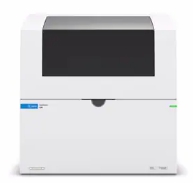| Service | Setup Fee | Per Sample | Setup Fee | Per Sample | Setup Fee | Per Sample | Samples per Setup Fee |
|---|---|---|---|---|---|---|---|
| Agilent 4200 TapeStation D5k | $26.09 | $9.91 | $30.01 | $11.40 | $33.92 | $12.89 | 15 |
| Agilent TapeStation D1000 | $26.26 | $9.99 | $30.20 | $11.49 | $34.14 | $12.99 | 15 |
| Agilent TapeStation Genomic DNA | $27.78 | $11.84 | $31.94 | $13.61 | $36.11 | $15.39 | 15 |
| Agilent TapeStation High Sensitivity D1000 | $29.03 | $11.66 | $33.39 | $13.41 | $37.74 | $15.16 | 15 |
| Agilent TapeStation High Sensitivity D5000 | $29.00 | $12.84 | $33.35 | $14.77 | $37.70 | $16.70 | 15 |
| Agilent TapeStation High Sensitivity RNA | $28.73 | $10.11 | $33.04 | $11.62 | $37.35 | $13.14 | 15 |
| Agilent TapeStation RNA | $27.57 | $9.58 | $31.71 | $11.02 | $35.84 | $12.46 | 15 |
The BPF is equipped with Agilent TapeStation instruments to assist with DNA and RNA analysis. Note: As of 2024, Agilent phased out support for the Bioanalyzer, and so we no longer offer Bioanalyzer as an option.
The Tapestation, a microfluidic alternative to gel electrophoresis, provides the same information as the Bioanalyzer once did, for a much lower cost and faster run time. This high-throughput automated electrophoresis platform for nucleic acid sample quality control is able to run up to 96 samples at a time. Results can be viewed as an electropherogram or as a standard gel-like image.
While Nanodrop or Qubit provide only concentration information, and Nanodrop tends to vastly overestimate concentration due to salts, proteins, and residual chemicals from extraction procedures, which can absorb light at the same wavelength as nucleic acids. Tapestation assays use a fluorescent intercalating dye to more specifically bind the DNA or RNA being measured. Unlike Nanodrop or Qubit, Tapestation results also provide sizing information for evaluating fragmentation efficiency, degradation, library prep success, and other applications.
On occasion, a sample will not fall neatly into a Tapestation's functional range (for either concentration or size). In these cases, we may develop a better picture of the sample by using Qubit in addition to Tapestation.
Results are usually returned same or next business day. For questions or assistance choosing an assay, please email info@genome.med.harvard.edu
The TapeStation has the ability to determine the quantity and quality of varying DNA and RNA sample types. These technologies can also be used to evaluate Next-Gen libraries. There are a variety of ScreenTapes to choose from, depending on the type and size range of your samples. Each run includes a ladder, as well as a pair of upper and lower markers. The marker and the ladder aid in determining the size and quality of the sample. Our core also use the ladder and markers to evaluate run success, or to identify any instrument issues before distributing results. Results are distributed in two forms: a PDF file, as well as an instrument software-specific file (.D1K, .D5K, etc for the TapeStation). You must download Agilent software to view and manipulate the instrument specific files. Our staff are happy to provide training on independent analysis using the software by email to scheduling an appointment. Links to the downloads are available in our Data Analysis section.
- Agilent TapeStation 4200 Instruments
- Thermo Fisher Qubit 3 Fluorometer
Please bring your order form and samples to our drop-off freezer just outside of our facility, any time. For RNA samples, we recommend only dropping samples off during business hours (9:00 am - 5:00 pm, Monday - Friday). Directions to our facility can be found here
All samples should meet the following criteria:
- Provide at least 2uL of each sample.
- Samples must meet concentration criteria, listed below. Please dilute your samples if they are out of range. If you are unsure of the concentration, we recommend picking the "High Sensitivity" version of the assay.
- Submit samples in a 0.2mL PCR tube.
- Label tubes with sample name.
- Samples should be on ice during transport to the drop-off freezer.
| Instrument | Chip or ScreenTape | Nucleic Acid Type | Concentration Range |
|---|---|---|---|
| Agilent TapeStation | D1000 | DNA | 0.1 ng/ul to 50 ng/ul |
| Agilent TapeStation | D5000 | DNA | 0.1 ng/ul to 50 ng/ul |
| Agilent TapeStation | Genomic | DNA | 10 ng/ul to 100 ng/ul |
| Agilent TapeStation | High Sensitivity D1000 | DNA | 10 pg/ul to 1000 pg/ul |
| Agilent TapeStation | High Sensitivity D5000 | DNA | 10 pg/ul to 1000 pg/ul |
| Agilent TapeStation | High Sensitivity RNA | RNA | 500 pg/ul to 10000 pg/ul |
| Agilent TapeStation | RNA | RNA | 25 ng/ul to 500 ng/ul |
For additional protocols and documentation, please visit the Agilent website http://www.agilent.com/.
We review the traces from each ScreenTape to look for run anomalies and will repeat samples that have poor data as a result of an instrument or reagent problem. Otherwise, it is your responsibility to evaluate the data for quality and concentration. For RNA, a RNA Integrity Number Equivalent (RINe) value (TapeStation) is generated to represent RNA quality. More details regarding these values can be found on the Agilent website.
You must download Agilent software if you wish to view and manipulate the instrument specific files. The link below will bring you to a registration form, which you must fill out in order to download the Analysis software.

